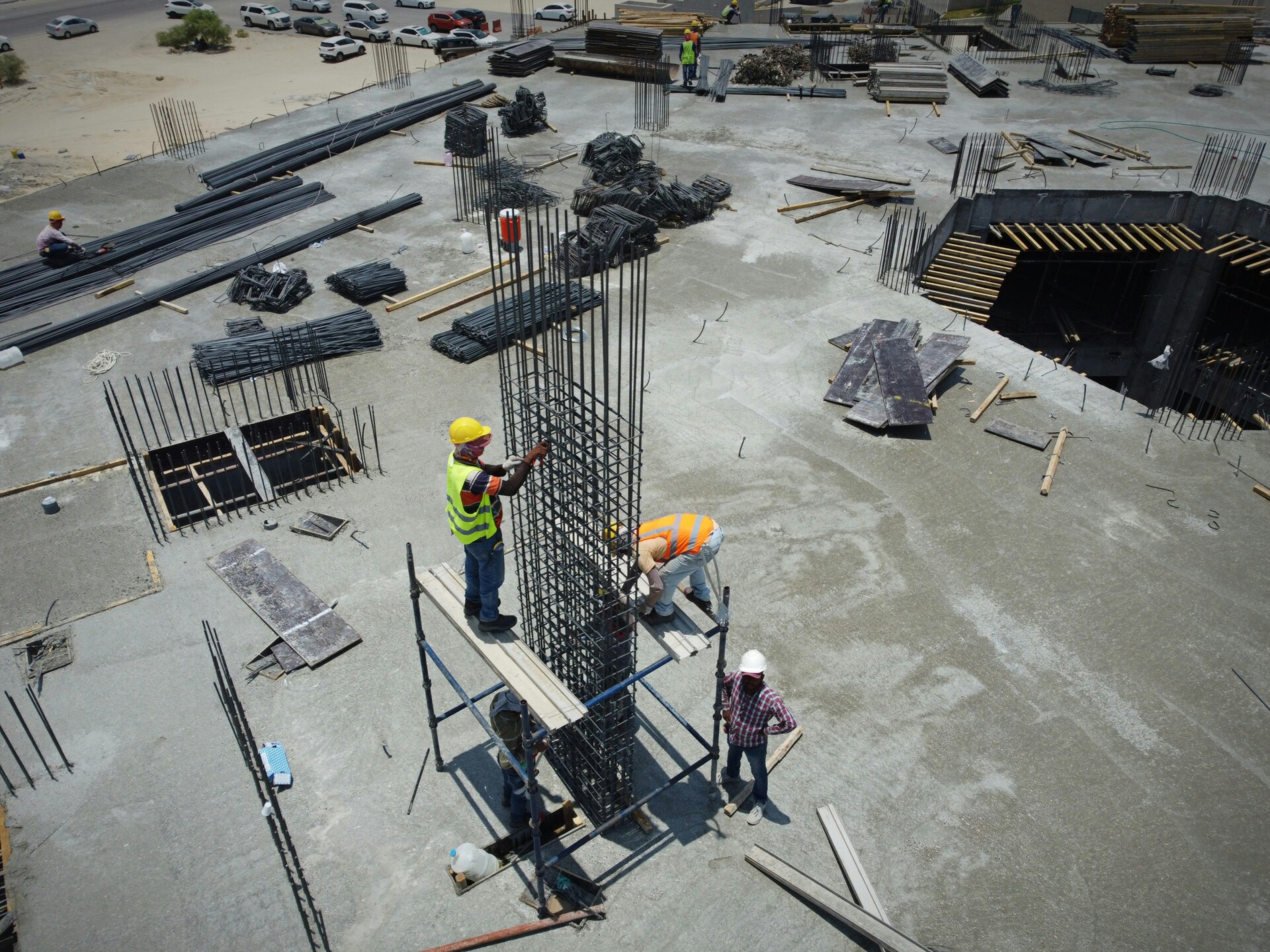Construction contract regulations establish the legal framework governing how projects move from initial planning through final closeout. These standards encompass building codes that dictate structural requirements, safety regulations that protect workers and the public, environmental guidelines that address waste management and emissions, and zoning laws that control land use and development rights.
When we execute construction projects, these regulations directly influence every contract clause we draft and every risk allocation decision we make. This comprehensive regulatory framework determines payment structures, establishes dispute resolution pathways, and defines site safety responsibilities that shape how construction teams coordinate daily operations and manage project delivery.
Which Laws And Codes Must Your Contracts Comply With?

Construction contracts operate under a comprehensive framework of regulations that vary by jurisdiction but share common foundations. We structure every agreement to meet applicable building codes, safety standards, environmental requirements, and zoning regulations that govern our project sites.
Building Codes And Construction Standards
All U.S. states have adopted the International Building Code as their foundation, though most customize it for local conditions. The International Code Council develops model codes that establish minimum requirements for structural systems, HVAC, plumbing, and electrical work. These codes set the baseline for how we design and build everything from foundations to roofing systems.
The International Fire Code and International Energy Conservation Code enjoy widespread adoption with local modifications. Fire safety provisions address sprinkler systems, egress requirements, and fire-resistant materials. Energy codes focus on insulation standards, window performance, and mechanical system efficiency. States like California layer additional energy requirements through Title 24, while Texas maintains distinct licensing protocols for contractors.
Safety And Health Requirements
OSHA regulations form the backbone of construction safety requirements in our contracts. These standards mandate specific training programs, protective equipment protocols, and emergency response procedures. We build these requirements directly into project specifications and subcontractor agreements.
Safety compliance extends beyond basic protective measures. OSHA requires documentation of incident reports, regular safety training records, and hazard communication protocols. Contracts must address fall protection systems, electrical safety standards, and trenching requirements. Non-compliance triggers immediate work stoppages and substantial penalties that can derail project schedules.
Environmental Regulations And Compliance
Environmental rules push construction toward energy efficiency, waste reduction, and emission controls. EPA regulations govern everything from stormwater runoff to air quality during construction activities. Projects near water bodies face Clean Water Act requirements, while older buildings trigger asbestos and lead paint regulations.
Municipal environmental standards often exceed federal minimums. Local jurisdictions implement green building requirements, construction waste diversion mandates, and noise ordinances. We coordinate these requirements early in project planning to avoid costly mid-stream changes and delays.
Zoning And Permitting Requirements
Municipal zoning bylaws control land use, building heights, setbacks, and occupancy types. These regulations determine what can be built where and establish the foundation for all construction contracts. Zoning compliance affects everything from site layout to parking requirements and loading dock locations.
Building permits represent the formal approval process that validates design compliance with all applicable codes. Permit timing controls project schedules, and permit conditions become binding contract requirements. Some jurisdictions require additional approvals for utility connections, environmental impacts, or historic preservation considerations.
Federal Project Requirements
Federal projects layer additional requirements on top of local codes and standards. Federal acquisition clauses address labor standards, small business participation, and buy-American provisions. These projects must meet both local building codes and federal agency-specific requirements that can exceed local standards.
Davis-Bacon prevailing wage requirements apply to most federal construction projects. Federal environmental reviews under NEPA can extend approval timelines significantly. We factor these additional layers of compliance into contract pricing and scheduling for all federal work.
Non-compliance with any of these regulatory frameworks triggers serious consequences. Fines and penalties accumulate quickly, while stop-work orders can halt entire projects. Building departments can revoke permits, utilities can refuse connections, and insurance coverage can lapse. These risks make regulatory compliance a fundamental aspect of successful construction contracting.
How Do Regulations Shape Risk Allocation And Key Contract Clauses?
Legal regulations serve as the foundation for how we structure risk allocation and craft essential contract clauses in construction projects. These regulatory frameworks establish boundaries that guide our approach to distributing responsibilities between owners and contractors, creating predictable mechanisms for handling unforeseen circumstances.
Force Majeure Protection From Uncontrollable Events
Force majeure clauses protect both parties from extraordinary circumstances beyond their control. We structure these provisions to excuse performance when natural disasters, labor strikes, or government actions prevent project completion. Most force majeure clauses allow time extensions for affected work, though cost allocation varies by contract form.
The clause typically requires prompt notice within 14 to 28 days of the event’s occurrence. We ensure contractors understand their duty to mitigate impacts and resume work once conditions allow. Without proper force majeure provisions, parties face uncertainty about responsibility for delays caused by circumstances neither could prevent or foresee.
Differing Site Conditions And Subsurface Risk
Differing site conditions clauses address one of construction’s most common risk areas: unexpected underground conditions. These provisions typically require contractors to give immediate notice when they encounter conditions materially different from those indicated in contract documents or reasonably foreseeable by experienced contractors.
The risk allocation often favors owners, particularly when site investigation data was provided. Contractors must demonstrate the conditions were unforeseeable and provide detailed cost and schedule impacts. We emphasize the critical importance of timely notice, as delayed notification can waive claims entirely.
Documentation becomes essential when subsurface conditions differ from expectations. Contractors should photograph conditions, preserve samples, and maintain detailed records to support potential claims.
Change-In-Law Cost Allocation
Regulatory changes during construction can significantly impact project costs and schedules. Change-in-law clauses establish how parties handle new regulations, code updates, or permit requirements that arise after contract execution.
Many standard contract forms place the risk of unforeseeable regulatory changes on owners. This allocation recognizes that owners ultimately benefit from completed facilities and have greater ability to absorb regulatory compliance costs. Contractors typically bear responsibility for changes that were reasonably foreseeable at the time of contracting.
We track regulatory developments throughout project duration and maintain clear procedures for documenting change-in-law impacts. Early identification allows for smoother cost and schedule adjustments through established change order processes.
Liquidated Damages For Project Delays
Liquidated damages clauses establish predetermined compensation for contractor-caused delays, eliminating the need to prove actual damages. These provisions must represent reasonable pre-estimates of anticipated harm, not punitive penalties against contractors.
Courts examine liquidated damages amounts based on circumstances known when contracts were executed. Unreasonably high amounts risk being declared unenforceable penalties. We calculate these provisions based on genuine cost impacts like extended overhead, financing costs, or lost revenue opportunities.
Concurrent delays present particular challenges for liquidated damages application. When both owner and contractor contribute to project delays, liquidated damages typically cannot be assessed for periods of concurrent delay. Clear documentation of delay causation becomes critical for proper application of these provisions.
Payment Mechanisms And Cash Flow Protection
Payment clauses establish cash flow mechanisms that keep projects moving forward. Retention provisions typically withhold around 5% of progress payments to secure contractor performance, with possible reductions at project milestones. These funds are released upon substantial completion and satisfaction of punch list items.
Prompt payment rules require owners to process contractor invoices within specified timeframes, often 30 days. Some states impose interest penalties for late payments and restrict “pay if paid” clauses that condition subcontractor payments on owner payments to general contractors.
We structure payment terms to balance owner security with contractor cash flow needs. Clear invoice requirements, defined approval processes, and established payment schedules reduce disputes and maintain project momentum.
Notice Requirements And Timing Deadlines
Construction contracts contain numerous notice requirements with strict deadlines that can make or break claims. Courts generally uphold shortened notice periods when they provide reasonable time for identification and communication of issues.
Notice provisions typically require written communication within specific timeframes after discovering problems. Some jurisdictions demand strict compliance with notice requirements, while others allow substantial compliance if the owner receives adequate information to investigate claims.
We emphasize the importance of timely, detailed notices that identify issues, quantify impacts, and preserve claim rights. Project teams must understand that failing to meet notice deadlines often waives otherwise valid claims entirely.
Implied Duties And Performance Standards
Beyond express contract terms, construction agreements include several implied duties that courts consistently recognize. The duty of good faith requires parties to act honestly and fairly in contract performance. Neither party may hinder the other’s performance or take advantage of superior bargaining positions.
Contractors have implied duties to perform work in a workmanlike manner using industry-standard methods and materials. Design professionals must meet prevailing standards of care for their disciplines. These implied obligations create performance baselines even when contracts lack specific quality requirements.
We ensure our teams understand these fundamental duties that apply regardless of express contract language. Meeting implied performance standards helps avoid disputes and maintains professional relationships throughout project delivery.
Performance Bonds And Insurance Protection
Performance and payment bonds provide financial security for project completion and subcontractor payments. We typically secure performance bonds equal to the full contract value, with payment bonds protecting suppliers and trade contractors from non-payment risks.
Insurance requirements include general liability coverage, workers’ compensation, and automotive insurance as basic protections. Complex projects may require builder’s risk insurance for construction period coverage and professional liability insurance for design responsibilities.
We coordinate insurance coverage between all project participants to avoid gaps or overlaps. Proper insurance procurement and certificate management ensure coverage remains in force throughout project duration and protects against various liability exposures.
What Contract Types And Delivery Methods Fit Within These Regulations?

Contract types and delivery methods shape how we comply with regulations and allocate project risks. Each approach creates different pathways for flowing down code requirements, safety obligations, and environmental duties through the project team.
Fixed-Price And Cost Structures
Fixed-price contracts, commonly called lump sum agreements, establish a set price for the entire project scope. We use these when project requirements are well-defined and regulatory compliance costs can be accurately estimated upfront. The contractor assumes responsibility for meeting all code requirements within the agreed price, including any unforeseen compliance costs that emerge during construction.
Cost-plus contracts reimburse actual project costs plus a predetermined fee or percentage. This structure works well when regulatory requirements are evolving or complex, allowing us to address compliance issues as they arise without renegotiating the base contract. The owner retains more control over compliance decisions but also bears the financial risk of regulatory changes.
Time and materials contracts charge hourly rates for labor plus material costs. We often use this structure for specialized compliance work, such as environmental remediation or historic preservation requirements where the scope cannot be precisely defined at contract signing. These agreements require careful documentation to track compliance-related hours and materials.
Unit Price Applications
Unit price contracts establish fixed rates for specific, repeatable work items. This approach proves effective for infrastructure projects where regulatory compliance requirements are consistent across multiple units of work. For example, we might establish unit prices for compliant roadway construction that includes all necessary environmental protections and safety measures per linear foot.
The unit price structure allows for quantity adjustments while maintaining cost predictability for compliance elements. When dealing with federal procurement codes, this method simplifies the bidding process by establishing clear, comparable pricing for standardized compliance requirements.
Design-Build Integration
Design-build delivery places both design and construction responsibility under a single contract. This method streamlines compliance by eliminating the traditional handoff between design and construction teams. We can address code requirements and regulatory constraints earlier in the design process, reducing change orders and compliance conflicts during construction.
The integrated approach particularly benefits projects with complex environmental or safety regulations. Our design-build teams coordinate regulatory approvals alongside design development, creating more efficient permitting processes and reducing overall project timelines.
Specialized Delivery Methods
Engineering, Procurement, and Construction (EPC) contracts combine all project phases under one agreement, often with a guaranteed maximum price. This delivery method works well for industrial projects with extensive regulatory requirements, as the EPC contractor manages all compliance aspects from engineering through startup.
Integrated Project Delivery (IPD) creates shared risk and reward structures among owner, designer, and builder. This collaborative approach helps align all parties around compliance goals, as regulatory failures affect everyone equally. Public-Private Partnerships (P3) blend public oversight with private sector efficiency, particularly useful for infrastructure projects requiring long-term compliance management.
Public Works Considerations
Federal procurement rules add layers of compliance requirements through specific agency clauses and procurement codes. Public works projects must incorporate prevailing wage requirements, disadvantaged business enterprise goals, and federal acquisition regulations into their contract structures.
We structure these contracts to clearly flow down federal compliance requirements to subcontractors and suppliers. This includes incorporating specific clauses for Buy American requirements, Davis-Bacon wage determinations, and environmental justice considerations that apply to federally funded projects.
Construction Management Approaches
Construction Management at Risk (CMAR) provides the owner with construction expertise during design while transferring completion risk to the construction manager. We typically hold the trade contracts directly, allowing better control over compliance requirements and specialized trade packages.
Construction Management as Advisor maintains the traditional owner-contractor relationships while providing professional construction guidance. This approach gives owners more direct control over compliance decisions and contractor selection, particularly important when specialized regulatory expertise is required.
| Contract Type | Risk Allocation | Compliance Responsibility |
|---|---|---|
| Fixed-Price | High risk for contractors due to potential cost overruns | Contractor responsible for all compliance costs within the agreed price |
| Cost-Plus | Low risk for contractors as they are reimbursed for all costs | Owner retains greater control but bears financial risk of regulatory changes |
| Time and Materials | Low risk due to compensation for all hours worked and materials used | Contractor documents compliance-related hours and materials |
| Guaranteed Maximum Price (GMP) | Shared risk with cost protection up to a cap | Owner and contractor must manage compliance costs to stay under cap |
| Unit Price | Medium risk and benefit depending on accurate estimation of quantities | Contractor paid per unit with compliance included in unit rate |
The choice between these approaches affects how compliance requirements flow through the project team and where ultimate responsibility rests for meeting regulatory standards. We consider project complexity, owner experience, and regulatory environment when recommending the optimal structure for each situation.
How Are Disputes Resolved Under Construction Contract Regulations?
When disputes arise during construction projects, contract regulations establish clear pathways for resolution. These processes move from collaborative to adversarial approaches, each with distinct procedures and timelines we navigate based on the project’s specific requirements.
Mediation and Early Resolution Methods
Most construction contracts require mediation as the first formal step in dispute resolution. This non-binding process brings a neutral mediator to facilitate discussions between parties, helping them understand each other’s positions and work toward settlement.
Mediation typically takes weeks rather than months to complete. We find it particularly effective because it preserves working relationships while projects remain active, allowing construction to continue during negotiations.
Large projects often incorporate Dispute Review Boards that provide early recommendations before conflicts escalate. These boards consist of industry experts who review claims and offer advisory opinions, helping parties assess the strength of their positions before pursuing binding resolution methods.
Arbitration Process and Limitations
When mediation fails, many contracts mandate binding arbitration through organizations like the American Arbitration Association. Arbitration offers streamlined procedures compared to court litigation, with arbitrators who understand construction industry practices and technical issues.
Domestic arbitration features limited discovery, focusing only on essential documents and testimony rather than the extensive fact-finding typical in court cases. This restriction controls costs but may limit parties’ ability to fully develop their cases.
Appeal rights remain very narrow in arbitration. Courts can only overturn arbitral awards in exceptional circumstances such as arbitrator bias or procedural violations, making the initial decision effectively final in most cases.
International Awards and Enforcement
For projects involving international parties or cross-border elements, arbitral awards receive enforcement under the New York Convention. This treaty allows U.S. courts to recognize and enforce international arbitration decisions, providing consistent resolution mechanisms across jurisdictions.
International awards enforcement streamlines collection and compliance processes that might otherwise require separate legal proceedings in multiple countries. This framework proves essential for large infrastructure projects with multinational contractors and suppliers.
Litigation and Court Procedures
When arbitration clauses don’t exist or specific circumstances require court intervention, litigation follows established civil procedures. The process begins with pleadings where each party states their claims and defenses, followed by discovery phases that can extend for months.
Discovery in litigation allows broader document production, depositions, and expert witness preparation than arbitration permits. This comprehensive fact-gathering often reveals critical project details but significantly increases time and costs.
Courts may grant summary judgment when facts aren’t disputed and legal issues can be resolved without trial. Otherwise, cases proceed to trial followed by potential appeals, creating timelines that often span multiple years from filing to final resolution.
Specialized Payment and Safety Enforcement
Some states maintain prompt payment processes specifically for undisputed invoice amounts, allowing contractors to recover funds without full dispute resolution procedures. These mechanisms recognize that cash flow issues can halt projects even when underlying work quality isn’t questioned.
Right to Cure laws in residential construction provide homeowners notice requirements and opportunities for contractors to address alleged defects before formal legal proceedings begin. These statutes balance consumer protection with practical repair solutions.
Building safety violations typically bypass standard contract dispute procedures entirely. Local agencies handle code compliance through citations, fines, and administrative appeals rather than civil litigation, ensuring public safety concerns receive immediate attention regardless of contractual relationships.
Conclusion And Next Steps For Compliant Contracting

Navigating construction contract regulations requires a systematic approach built on prevention rather than reaction. We structure every agreement around the regulatory foundation that governs our projects. This means identifying applicable building codes, OSHA requirements, environmental standards, and zoning restrictions before contract language is finalized. Each clause must align with these requirements to create enforceable terms that protect all parties.
Ready to start a construction project with a team that prioritizes compliance and quality from day one? Contact EB3 Construction to partner with builders who deliver projects that meet all regulatory requirements while staying on schedule.




